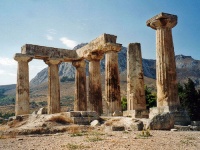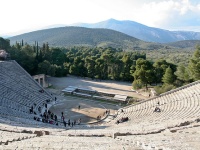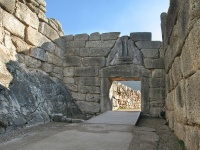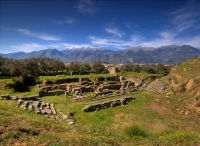
Ancient Corinth is rests around the base of Acrocorinth. Originally a Greek acropolis, this lofty fortress hill has been a Roman citadel, a Byzantine castle and more over the course of its history.Most of the city's surviving buildings are Roman, though. Caesar built them after his armies sacked much of the original settlement. Since then, recurring earthquakes have toppled large parts of ancient Corinth. Still, enough of it remains to fire up the imagination. The 6th-century BC Temple of Apollo is particularly beautiful. It sits on a hill overlooking the marketplace's remains.Visitors will find an archaeological museum in the site's southwest corner. It contains some worthwhile collections of mosaic floors, pottery and works of art.
Website : www.ancientcorinth.net

A definite must on a tour of the Peloponnese is the famed ancient theatre of Epidaurus, built in the 3rd century BC and so well preserved that with little or no restoration it is still in use today for regular summer dramatic performances, which are lent a mystical aura by the beautiful and ancient setting. The theatre has perfect acoustics, allowing even a whisper on stage to be heard in the back row of the limestone amphitheatre, which can seat 14,000. North of the theatre are the ruins of the healing Sanctuary of Asklepios, which has a museum explaining how the original temple complex would have looked and functioned. This was once the most famous healing centre of the Greek and Roman world, and some argue that it is the birthplace of modern medicine. It is very interesting to learn about the evolution of medical treatment in this place and to explore the ruins and remains of the sanctuary, which once spawned 200 dependent spas throughout the Mediterranean. Where the ancient town of Epidaurus once stood there is now the modern day village of Palia Epidaurus. This is a popular seaside resort with scenic beaches, a small harbour and several tavernas.
Address : Archaeological Museum of Epidaurus, Asklepieion.

This ancient site, 31 miles (50km) south of Corinth, bears the remains of the ancient palace and citadel of Mycenae, a place of archaeological controversy but fascinating for the lay visitor. Homer's fabulous story has it that the kingdom of Mycenae was dripping in gold and revelling in riches before King Agamemnon decided to lead an assault on Troy, back in about 1,250 BC. The king started a war that lasted a decade, battling to win the impossibly beautiful Helen of Troy back from Prince Paris. German archaeologist Heinrich Schliemann discovered Mycenae, which he believed gave credence to Homer's tale, in 1874 after he had excavated the remains of Troy itself. There is no doubt that Mycenae was a city of power and prosperity and the ruins, from the Lion Gate (oldest example of monumental sculpture in Europe) to the palace complex, houses and beehive tomb of Agamemnon, are well worth exploring. Most of the more exceptional finds from the site are on exhibit in the National Archaeological Museum in Athens. These include frescoes, gold jewellery, and the gold mask said to have belonged to Agamemnon, among other priceless pieces.
Among shady pine, olive and oak trees, in a valley between Mount Kronos and the Alfios River on the Peloponnese Peninsula, lies one of the most famous historical and archaeological sites in Greece. Olympia includes the remains of two ancient temples and the stadium where the first Olympic Games took place in 776 BC. Since the modern Olympics were inaugurated in 1896 torchbearers have set out from Olympia to carry the Olympic flame in relays across the world to wherever the games are held every four years. The site also boasts one of the finest archaeological museums in Greece. The ruins themselves are fascinating, being the remnants of an ancient Olympic village including a gymnasium, baths, the Prytaneion - where winners were honoured - and a Doric Temple dedicated to Hera. In the nearby modern village of Olympia there is another museum that is often sadly overlooked: the Museum of the Olympic Games contains some interesting memorabilia from games past and gives those interested in the event a fantastic overview of its history and significance.

Made popular again by the 2006 film 300, the ancient city of Sparta sits in the middle of the Plains of Laconia in the Peloponnese, which is one of the most historic regions in the world. Sparta emerged as a political entity around the 10th century BC and by 650 BC was rising to be a dominant military power in ancient Greece. It was recognised as the leader of the Greek forces in the Greco-Persian Wars, from which Greece eventually emerged victorious but at great cost to Sparta, and many other city-states. By 146 BC Sparta had lost its independence to Roman conquest. The Spartans were fiercely militaristic and their whole way of life was centred around military training and prowess. The Spartans were a legendary military force, and are still referenced in military strategy. At the archaeological site visitors can view the excavations and ruins and visit the tomb of King Leonidas, the sanctuary of Artemis Orthia, and the Sparta Archaeological Museum in town, as well as view a number of ruins and ancient churches in nearby Mystras. The famous battlefield of Thermopylae can also still be visited and there are several monuments there to the Spartan force that was wiped out after extreme feats of prowess and bravery, including a monument to King Leonidas.

Travel Guide powered by Word Travels, copyright © 2023 Globe Media Ltd. By its very nature information in this travel guide is subject to change at short notice and travellers are urged to verify information on which they're relying with the relevant authorities. Neither Globe Media Ltd nor Travel Vogue can accept any responsibility for any loss or inconvenience to any person as a result of information contained above.